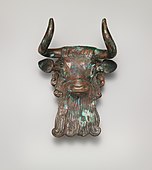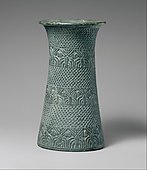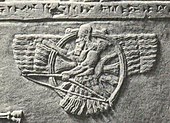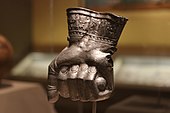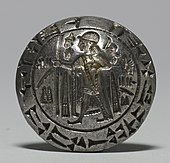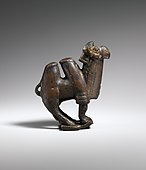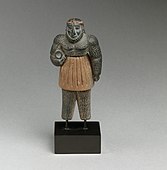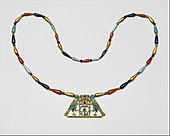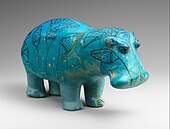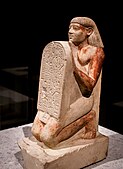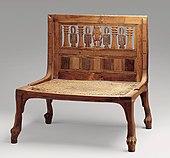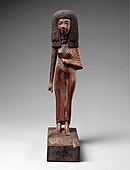
A | B | C | D | E | F | G | H | CH | I | J | K | L | M | N | O | P | Q | R | S | T | U | V | W | X | Y | Z | 0 | 1 | 2 | 3 | 4 | 5 | 6 | 7 | 8 | 9
 Alexander the Great (left), wearing a kausia and fighting an Asiatic lion with his friend Craterus; late 4th century BC; mosaic; Archaeological Museum of Pella (Pella, Greece) | |
| Years active | Antiquity |
|---|---|
| History of art |
|---|
| Ancient art history |
|---|
| Middle East |
| Asia |
| European prehistory |
| Classical art |
Ancient art refers to the many types of art produced by the advanced cultures of ancient societies with different forms of writing, such as those of ancient China, India, Mesopotamia, Persia, Palestine, Egypt, Greece, and Rome. The art of pre-literate societies is normally referred to as prehistoric art and is not covered here. Although some pre-Columbian cultures developed writing during the centuries before the arrival of Europeans, on grounds of dating these are covered at pre-Columbian art and articles such as Maya art, Aztec art, and Olmec art.[citation needed]
Middle East and Mediterranean
Mesopotamia
Mesopotamia (from the Greek Μεσοποταμία " between the rivers", in Syriac called ܒܝܬ ܢܗܪܝܢ pronounced "Beth Nahrain", "Land of rivers", rendered in Arabic as بلاد الرافدين bilād al-rāfidayn) is a toponym for the area of the Tigris-Euphrates river system, largely corresponding to modern-day Iraq, as well as some parts of northeastern Syria, southeastern Turkey, and southwestern Iran. Within its boundaries, some of the most ancient civilizations known first developed writing and agriculture. Many civilizations flourished there, leaving behind a rich legacy of ancient art.[citation needed]
Bronze Age Mesopotamian civilizations included the Akkadian, Babylonian, and Assyrian empires, and Sumer. In the Iron Age, Mesopotamia was ruled by the Neo-Assyrian and Neo-Babylonian empires. The indigenous Sumerians and Akkadians (including Assyrians & Babylonians) dominated Mesopotamia from the beginning of written history (c. 3100 BC) to the fall of Babylon in 539 BC, when it was conquered by the Achaemenid Empire. It fell to Alexander the Great in 332 BC and after his death, it became part of the Greek Seleucid Empire.
Around 150 BC, Mesopotamia was under the control of the Parthians. Mesopotamia became a battleground between the Romans and Parthians, with parts of Mesopotamia (particularly Assyria) coming under periodic Roman control. In 226 AD, it fell to the Sassanid Persians and remained under Persian rule until the 7th-century Arab Islamic conquest of the Sassanid Empire. A number of primarily Christian native Mesopotamian states existed between the 1st century BC and the 3rd century AD, including Adiabene, Oshroene, and Hatra.
Sumer
Archaeological evidence attests to their existence during the 5th millennium BC. The Sumerians decorated their pottery with cedar oil paints. The Sumerians also developed jewelry.
A notable example of surviving Sumerian art is the Standard of Ur, dated to approximately 2500 BC. The Standard is a wooden box inlaid with shells and lapis lazuli depicting soldiers presenting their king with prisoners on one side and peasants presenting him with gifts on the other.
-
Cuneiform tablet; 3100–2900 BC; clay; 5.5 x 6 x 4.15 cm; Metropolitan Museum of Art (New York City)
-
Standing male worshiper, one of the twelve statues in the Tell Asmar Hoard; 2900–2600 BC; gypsum alabaster, shell, black limestone and bitumen; 29.5 x 12.9 x 10 cm; Metropolitan Museum of Art
-
Headdress; 2600–2500 BC; gold (the leaves), lapis lazuli (the blue beads) and carnelian (the orange beads); length: 38.5 cm; Metropolitan Museum of Art
-
Ram in a Thicket; 2600–2400 BC; gold, copper, shell, lapis lazuli and limestone; height: 45.7 cm; from the Royal Cemetery at Ur (Dhi Qar Governorate, Iraq); British Museum (London)
-
Standard of Ur; 2600–2400 BC; shell, red limestone and lapis lazuli on wood; length: 49.5 cm; from the Royal Cemetery at Ur; British Museum
-
Bull's head ornament from a lyre; 2600–2350 BC; bronze inlaid with shell and lapis lazuli; height: 13.3 cm, width: 10.5 cm; Metropolitan Museum of Art
-
Golden helmet of Meskalamdug, possible founder of the First Dynasty of Ur, 26th century BC.
-
Votive figure; 2600–2350 BC; stone; height: 41.3 cm, width: 14.5 cm, depth: 13.5 cm; Metropolitan Museum of Art
-
Vase with overlapping pattern and three bands of palm trees; mid- to late 3rd millennium BC; chlorite; height: 23.5 cm; Metropolitan Museum of Art
-
The Statue of Ebih-Il; c. 2400 BC; gypsum, schist, shells and lapis lazuli; height: 52.5 cm, width: 20.6 cm; discovered by André Parrot at the Temple of Ishtar (Mari, Syria); Louvre
-
Fragment of a bas-relief with goddess Ninsun; 2255–2040 BC; steatite; height: 14 cm; Louvre
-
Statue of Gudea O; circa 2100 BC; steatite; height: 0.63 m; Ny Carlsberg Glyptotek (Copenhagen, Denmark)
Babylon
The conquest of Sumer and Akkad by Babylon marks a turning point in the artistic and political history of the region.
The Babylonians took advantage of the abundance of clay in Mesopotamia to create bricks. The use of brick led to the early development of the pilaster and column, as well as of frescoes and enameled tiles. The walls were brilliantly colored, and sometimes plated with bronze or gold as well as with tiles. Painted terra-cotta cones were also embedded in the plaster.
The Babylonians often worked with metal. They created functional tools with copper. It is possible that Babylonia was the original home of copperworking, which then spread westward. In addition, the want of stone in Babylonia made every pebble precious and led to a high perfection of the art of gem-cutting. The arts of Babylon also included tapestries, and Babylonian civilization was famous for its tapestries and rugs.
-
Detail of Nebuchadnezzar II's Building Inscription plaque of the Ishtar Gate, from Babylon, Iraq. 6th century BC. Pergamon Museum
-
Female head; circa 2000–1600 BC; ceramic; 18 x 12.7 cm; Metropolitan Museum of Art (New York City)
-
Plaque with a nude female between two bearded males wearing kilts; circa 2000–1600 BC; bronze; 9.7 x 9.7 cm; Metropolitan Museum of Art
-
Cylinder seal with an impression; circa 18th–17th century BC; hematite; 2.39 cm; Metropolitan Museum of Art
-
Male head; circa late 8th–early 7th century; ceramic; 12.5 cm; Metropolitan Museum of Art
-
Facade of the Throne Room. Babylon, coloured, glazed bricks. 604–562 BC. The Throne-Room was situated in the third courtyard complex of the royal palace.
-
Remains of brick structures in Babylon
-
Contemporary artwork depicting Babylon at the height of its stature.
-
The Ishtar Gate was the eighth gate to the inner city of Babylon. It was constructed circa 575 BC by order of King Nebuchadnezzar II on the north side of the city.
-
Hammurabi (left), depicted as receiving his royal insignia from Shamash (or possibly Marduk). Hammurabi holds his hands over his mouth as a sign of prayer (relief on the upper part of the stele of Hammurabi's code of laws).
Assyria

When Babylon began to decline, it was conquered by Assyria, one of its former colonies. Assyria inherited its arts as well as its empire.
At first, Assyrian architects and artists copied Babylonian styles and materials. Later, Assyrians began to shake themselves free of Babylonian influences. The walls of the Assyrian palaces were lined with slabs of stone instead of brick and were colored instead of painted as in Chaldea. In place of the bas relief, we have sculpted figures, the earliest examples being the statues from Girsu.
No remarkable specimens of metallurgic art from early Assyria have been found, but at a later epoch, great excellence was attained in the manufacture of such jewellery as earrings and bracelets of gold. They also had skilled works using copper.
Assyrian pottery and porcelain were graceful. Transparent glass seems to have been first introduced in the reign of Sargon II, like the glass discovered in the palaces of Nineveh – derived from Egyptian originals. Stone, as well as clay and glass, were employed in the manufacture of vases. Vases of hard stone have been disinterred at Tello, similar to those of the early dynastic period of Egypt.
Ashurbanipal promoted art and culture and had a vast library of cuneiform tablets at Nineveh.
-
Shalmaneser III, on the Throne Dais of Shalmaneser III at the Iraq Museum.
-
A Neo-Assyrian relief of Ashur as a feather robed archer holding a bow instead of a ring (9th–8th century BC)
-
The Black Obelisk of Shalmaneser III. The king, surrounded by his royal attendants and a high-ranking official, receives a tribute from Sua, king of Gilzanu (north-west Iran), who bows and prostrates before the king. From Nimrud, northern Mesopotamia (Iraq). Neo-Assyrian period, 825 BC. The British Museum, London.
-
7th-century BC relief depicting Ashurbanipal (r. 669–631 BC) and three royal attendants in a chariot. From the North Palace at Nineveh
-
Glazed terracotta tile from Nimrud, with a court scene; 875–850 BC; fired and glazed clay; height (without base): 30.6 cm, height (with base): 38.3 cm; British Museum
-
Lammasu, an Assyrian protective deity. Initially depicted as a goddess in Sumerian times, when it was called Lamma, it was later depicted in Assyrian times as a hybrid of a human, bird, and either a bull or lion—specifically having a human head, the body of a bull or a lion, and bird wings, under the name Lamassu. Iraq Museum
-
Relief with a winged genie with bucket and cone; 713–706 BC; height: 3.3 m; Louvre
-
Lion weight; 6th–4th century BC; bronze; height: 29.5 cm; Louvre
-
Assyrian ornaments and patterns, illustrated in a book from 1920
-
Illustration of a hall in the Assyrian Palace of Ashurnasrirpal II by Austen Henry Layard (1854)
Hittite
Hittite art was produced by the Hittite civilization in ancient Anatolia, in modern-day Turkey, and also stretching into Syria during the second millennium BC from the nineteenth century up until the twelfth century BC. This period falls under the Anatolian Bronze Age. It is characterized by a long tradition of canonized images and motifs rearranged, while still being recognizable, by artists to convey meaning to a largely illiterate population.
"Owing to the limited vocabulary of figural types , invention for the Hittite artist usually was a matter of combining and manipulating the units to form more complex compositions"[1]
Many of these recurring images revolve around the depiction of Hittite deities and ritual practices. There is also a prevalence of hunting scenes in Hittite relief and representational animal forms. Much of the art comes from settlements like Alaca Höyük, or the Hittite capital of Hattusa near modern-day Boğazkale. Scholars do have difficulty dating a large portion of Hittite art, citing the fact that there is a lack of inscription and much of the found material, especially from burial sites, was moved from their original locations and distributed among museums during the nineteenth century.
-
Drinking cup in the shape of a fist; 1400–1380 BC; silver; from Central Turkey; Museum of Fine Arts (Boston, US)
-
Vessel terminating in the forepart of a stag; c. 14th–13th century BC; silver with gold inlay; height: 18 cm; Metropolitan Museum of Art (New York City)
-
Seal of Tarkasnawa, King of Mira; circa 1220 BC; silver; height: 1 cm, diameter: 4.2 cm; Walters Art Museum (Baltimore, US)
-
Three reliefs from the Adana Archaeology Museum (Turkey)
Bactrian
The Bactria–Margiana Archaeological Complex is the modern archaeological designation for a Bronze Age civilization of Central Asia, dated to c. 2300–1700 BC, in present-day northern Afghanistan, eastern Turkmenistan, southern Uzbekistan, and western Tajikistan, centred on the upper Amu Darya (Oxus River). Its sites were discovered and named by the Soviet archaeologist Viktor Sarianidi (1976).[citation needed] Monumental urban centres, palaces, and cultic buildings were uncovered, notably at Gonur-depe in Turkmenistan.
BMAC materials have been found in the Indus Valley civilisation, on the Iranian Plateau, and in the Persian Gulf.[2] Finds within BMAC sites provide further evidence of trade and cultural contacts. They include an Elamite-type cylinder seal and a Harappan seal stamped with an elephant and Indus script found at Gonur-depe.[3] The relationship between Altyn-Depe and the Indus Valley seems to have been particularly strong. Among the finds, there were two Harappan seals and ivory objects. The Harappan settlement of Shortugai in Northern Afghanistan on the banks of the Amu Darya probably served as a trading station.[4]
A famous type of Bactrian artwork is the "Bactrian princesses" (a.k.a. "Oxus ladies"). Wearing large stylized dresses with puffed sleeves, as well as headdresses that merge with the hair, they embody the ranking goddess, a character of the central Asian mythology that plays a regulatory role, pacifying the untamed forces. These statuettes are made by combining and assembling materials of contrasting colours. The preferred materials are chlorite (or similar dark green stones), a whitish limestone or mottled alabaster, or marine shells from the Indian Ocean.[5] The different elements of body and costume were carved separately and joined, as in a puzzle, by tenon and mortices glue.
-
Axe with eagle-headed demon & animals; late 3rd millennium-early 2nd millennium BC; gilt silver; length: 15 cm; Metropolitan Museum of Art (New York City)
-
Camel figurine; late 3rd–early 2nd millennium BC; copper alloy; 8.89 cm; Metropolitan Museum of Art
-
Female figurine of the "Bactrian princess" type; 2500–1500; chlorite (dress and headdress) and limestone (head, hands and a leg); height: 13.33 cm; Los Angeles County Museum of Art (US)
Achaemenid
Achaemenid art includes frieze reliefs, metalwork, decoration of palaces, glazed brick masonry, fine craftsmanship (masonry, carpentry, etc.), and gardening. Most survivals of court art are monumental sculptures, above all the reliefs, double animal-headed Persian column capitals and other sculptures of Persepolis.[6]
Although the Persians took artists, with their styles and techniques, from all corners of their empire, they produced not simply a combination of styles, but a synthesis of a new unique Persian style.[7] Cyrus the Great in fact had an extensive ancient Iranian heritage behind him; the rich Achaemenid gold work, which inscriptions suggest may have been a specialty of the Medes, was for instance in the tradition of earlier sites.
There are a number of very fine pieces of jewellery or inlay in precious metal, also mostly featuring animals, and the Oxus Treasure has a wide selection of types. Small pieces, typically in gold, were sewn to clothing by the elite, and a number of gold torcs have survived.[6]
-
Gold bracelet, part of the Oxus Treasure; 5th to 4th century BC; gold; width: 11.6 cm; British Museum (London)
-
Column capital; 5th to 4th century BC; stone; height: 1.75 m; from Persepolis; National Museum of Iran (Teheran)
Phoenician
Phoenician art lacks unique characteristics that might distinguish it from its contemporaries. This is due to its being highly influenced by foreign artistic cultures: primarily Egypt, Greece, and Assyria. Phoenicians who were taught on the banks of the Nile and the Euphrates gained a wide artistic experience and finally came to create their own art, which was an amalgam of foreign models and perspectives.[8] In an article from The New York Times published on January 5, 1879, Phoenician art was described by the following:
He entered into other men's labors and made most of his heritage. The Sphinx of Egypt became Asiatic, and its new form was transplanted to Nineveh on the one side and to Greece on the other. The rosettes and other patterns of the Babylonian cylinders were introduced into the handiwork of Phoenicia, and so passed on to the West, while the hero of the ancient Chaldean epic became first the Tyrian Melkarth, and then the Herakles of Hellas.
-
Decorative plaque which depicts a fighting of man and griffin; 900–800 BC; Nimrud ivories; Cleveland Museum of Art (Ohio, US)
-
Oinochoe; 800-700 BC; terracotta; height: 24.1 cm; Metropolitan Museum of Art (New York City)
-
Face bead; mid-4th–3rd century BC; glass; height: 2.7 cm; Metropolitan Museum of Art
-
Earring from a pair, each with four relief faces; late 4th–3rd century BC; gold; overall: 3.5 x 0.6 cm; Metropolitan Museum of Art
Pre-Islamic Arabia

The art of Pre-Islamic Arabia is related to that of neighbouring cultures. Pre-Islamic Yemen produced stylized alabaster heads of great aesthetic and historic charm. Most of the pre-Islamic sculptures are made of alabaster.
Archaeology has revealed some early settled civilizations in Saudi Arabia: the Dilmun civilization on the east of the Arabian Peninsula, Thamud north of the Hejaz, and Kinda and Al-Magar civilization in the central of Arabian Peninsula. The earliest known events in Arabian history are migrations from the peninsula into neighbouring areas.[9] In antiquity, the role of South Arabian societies such as Saba (Sheba) in the production and trade of aromatics not only brought such kingdoms wealth but also tied the Arabian peninsula into trade networks, resulting in far-ranging artistic influences.
It seems probable that before around 4000 BC the Arabian climate was somewhat wetter that today, benefitting from a monsoon system that has since moved south.[citation needed] During the late fourth millennium BC permanent settlements began to appear, and inhabitants adjusted to the emerging dryer conditions. In southwestern Arabia (modern Yemen) a moister climate supported several kingdoms during the second and first millennia BC. The most famous of these is Sheba, the kingdom of the biblical Queen of Sheba. These societies used a combination of trade in spices and the natural resources of the region, including aromatics such as frankincense and myrrh, to build wealthy kingdoms. Mārib, the Sabaean capital, was well positioned to tap into Mediterranean as well as Near Eastern trade, and in kingdoms to the east, in what is today Oman, trading links with Mesopotamia, Persia, and even India were possible. The area was never a part of the Assyrian or Persian empires, and even Babylonian control of north-west Arabia seems to have been relatively short-lived. Later Roman attempts to control the region's lucrative trade were foundered. This impenetrability to foreign armies doubtless augmented ancient rulers' bargaining power in the spice and incense trade.
Although subject to external influences, south Arabia retained characteristics particular to itself. The human figure is typically based on strong, square shapes, the fine modeling of detail contrasting with a stylized simplicity of form.
-
Stele of a male wearing a baldric; 4th millennium BC; sandstone; height: 92 cm; from Al-'Ula (Saudi Arabia); in a temporary exhibition in the National Museum of Korea (Seoul), named Roads of Arabia: Archaeological Treasures of Saudi Arabia
-
Standing female figure wearing a strap and a necklace; 3rd–2nd millennium BC; sandstone and quartzite; height: 27.5 cm, width: 14.3 cm, depth: 14.3 cm; from Mareb (Yemen); Metropolitan Museum of Art (New York City)
-
Incense burner; mid-1st millennium BC; bronze; height: 27.6 cm, width: 23.7 cm; depth: 23.3 cm; from Southwestern Arabia; Metropolitan Museum of Art
-
South Arabian head; 300-1 BC; alabaster; height: 20.5 cm, length: 11 cm, depth: 8.5 cm; Louvre
-
Decorated capital of a pillar from the royal palace of Shabwa; stratigraphic context: first half of the 3rd century BC; National Museum of Yemen (Aden)
-
Funerary stele; 1st-3rd centuries AD; alabaster; height: 55 cm, width: 29 cm, depth: 8 cm; Louvre
-
Perfume-burner with an ibex; 1st–3rd century AD; limestone; from Yemen; height: 30 cm, width: 24 cm, depth: 24 cm; Louvre
Egypt
Due to the highly religious nature of ancient Ancient Egyptian civilization, many of the great works of ancient Egypt depict gods, goddesses, and Pharaohs, who were also considered divine. The idea of order characterizes ancient Egyptian art. Clear and simple lines combined with simple shapes and flat areas of colour helped to create a sense of order and balance in the art of ancient Egypt. Ancient Egyptian artists used vertical and horizontal reference lines to maintain the correct proportions in their work. Political and religious, as well as artistic, order was also maintained in Egyptian art. To clearly define the social hierarchy of a situation, figures were drawn to sizes that were based not on their distance from the painter's perspective but on relative importance. For instance, the Pharaoh would be drawn as the largest figure in a painting no matter where he was situated, and a greater God would be drawn larger than a lesser god.
Symbolism also played an important role in establishing a sense of order. Symbolism, ranging from the Pharaoh's regalia (symbolizing his power to maintain order) to the individual symbols of Egyptian gods and goddesses, was omnipresent in Egyptian art. Animals were usually also highly symbolic figures in Egyptian art. Colour, as well, had extended meaning—blue and green represented the Nile and life; yellow stood for the sun god; and red represented power and vitality. The colours in Egyptian artifacts have survived extremely well over the centuries because of Egypt's dry climate.
Despite the stilted form caused by a lack of perspective, ancient Egyptian art is often highly realistic. Ancient Egyptian artists often show a sophisticated knowledge of anatomy and close attention to detail, especially in their renderings of animals. During the 18th Dynasty of Egypt a Pharaoh by the name of Akhenaton took the throne and abolished the traditional polytheism. He formed a monotheistic religion based on the worship of Aten, a sun god. Artistic change followed political upheaval. A new style of art was introduced that was more naturalistic than the stylized frieze favored in Egyptian art for the previous 1700 years. After Akhenaton's death, however, Egyptian artists reverted to their old styles.
Faience that was produced in ancient Egyptian antiquity as early as 3500 BC was in fact superior to the tin-glazed earthenware of the European 15th century.[10] Ancient Egyptian faience was not made of clay but instead actually of a ceramic composed primarily of quartz.
-
Stele of Princess Nefertiabet eating; 2589–2566 BC; limestone & paint; height: 37.7 cm, length: 52.5 cm, depth: 8.3 cm; from Giza; Louvre (Paris)
-
Pectoral and necklace of Princess Sithathoriunet; 1887–1813 BC; gold, carnelian, lapis lazuli, turquoise, garnet & feldspar; height of the pectoral: 4.5 cm; Metropolitan Museum of Art (New York City)
-
William the Faience Hippopotamus; 1961–1878 BC; faience; 11.2 × 7.5 cm; Metropolitan Museum of Art
-
Kneeling portrait statue of Amenemhat holding a stele with an inscription; circa 1500 BC; limestone; Egyptian Museum of Berlin (Germany)
-
Chair of Hatnefer; 1492–1473 BC; boxwood, cypress, ebony & linen cord; height: 53 cm; Metropolitan Museum of Art
-
Statuette of the lady Tiye; 1390-1349 BC; wood, carnelian, gold, glass, Egyptian blue and paint; height: 24 cm; Metropolitan Museum of Art
-
Mask of Tjuyu; c. 1387–1350 BC; gold, past of glass, alabaster and other materials; height: 40 cm; Egyptian Museum (Cairo)
-
The Mask of Tutankhamun; c. 1327 BC; gold, glass and semi-precious stones; height: 54 cm; Egyptian Museum
-
The entrance of the Great Temple of the Abu Simbel temples, founded around 1264 BC
-
Coffin of Nesykhonsu; c. 976 BC; gessoed and painted sycamore fig; overall: 70 cm; Cleveland Museum of Art (Cleveland, Ohio, US)
-
Complete set of canopic jars decorated with hieroglyphics; 744–656 BC; painted sycomore fig wood; various heights; British Museum (London)
-
Cosmetic box in the shape of an Egyptian composite capital, its cap being in the left side; 664–300 BC; glassy faience; 8.5 × 9 cm; Metropolitan Museum of Art
-
Statuette of Anubis; 332–30 BC; plastered and painted wood; 42.3 cm; Metropolitan Museum of Art
-
The well preserved The Temple of Isis from Philae (Egypt) is an example of Egyptian architecture and architectural sculpture
-
Illustration of various types of capitals, drawn by the egyptologist Karl Richard Lepsius
Zdroj:https://en.wikipedia.org?pojem=Ancient_art
Text je dostupný za podmienok Creative Commons Attribution/Share-Alike License 3.0 Unported; prípadne za ďalších podmienok. Podrobnejšie informácie nájdete na stránke Podmienky použitia.
Antropológia
Aplikované vedy
Bibliometria
Dejiny vedy
Encyklopédie
Filozofia vedy
Forenzné vedy
Humanitné vedy
Knižničná veda
Kryogenika
Kryptológia
Kulturológia
Literárna veda
Medzidisciplinárne oblasti
Metódy kvantitatívnej analýzy
Metavedy
Metodika
Text je dostupný za podmienok Creative
Commons Attribution/Share-Alike License 3.0 Unported; prípadne za ďalších
podmienok.
Podrobnejšie informácie nájdete na stránke Podmienky
použitia.
www.astronomia.sk | www.biologia.sk | www.botanika.sk | www.dejiny.sk | www.economy.sk | www.elektrotechnika.sk | www.estetika.sk | www.farmakologia.sk | www.filozofia.sk | Fyzika | www.futurologia.sk | www.genetika.sk | www.chemia.sk | www.lingvistika.sk | www.politologia.sk | www.psychologia.sk | www.sexuologia.sk | www.sociologia.sk | www.veda.sk I www.zoologia.sk






